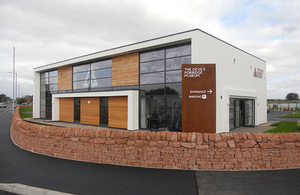Chapelcross and its place in Solway Heritage
This project involved creating a permanent record of the former Chapelcross nuclear power station as an exhibition in the local Devil’s Porridge Museum. The exhibition features Chapelcross employees and its contribution to the Scottish Solway Border communities.

The Devils Porridge Museum building
| Nearest NDA site | Duration | Total investment | Magnox contribution | Partners | Delivered by |
|---|---|---|---|---|---|
| Chapelcross | 2 years | £100,000 | £36,000 | Big Lottery, Holywood Trust | Eastriggs and Gretna Heritage Group |

Infographic summary of the project
Outcome:
- a permanent record of Chapelcross’ contribution to the Solway Coast area
- employ an Access and Learning Officer for 12 months to engage with young people
- create a bank of educational materials
- increase visitor numbers from 18,000 to 20,000
- increase from 40 to 44 volunteers
Chapelcross nuclear site has had a major economic and social impact on Annan, Eastriggs and Gretna communities over 60 years, bringing prosperity and expertise to the area.
Its important history has been recorded using various media for the benefit of future generations and is part of the displays at the Devil’s Porridge Museum (named after the explosive mixture manufactured at a now-demolished wartime munitions factory).
Rene Anderson, former Chapelcross Employee said:
Since participating in the Chapelcross Oral Report, I have been very impressed to see how the material from this project has been incorporated into the digital interactive experience. This has recorded for future generations the history of the Chapelcross nuclear power station – one of the area’s largest and most important employers for over half a century.
John Grierson, Chapelcross Site Closure Director, said:
Chapelcross, over its almost 60-year history, has always endeavoured to support the local community in a variety of projects. This new permanent exhibition is a great way to strengthen this connection.
What was involved?
Research was carried out into Chapelcross and past employees were interviewed. Design consultants brought the story to life by creating interactive displays. These involved 360° panoramas, oral testimonies by staff who had worked on construction through to decommissioning. Chapelcross management provided access to the reactor areas, and the video footage was used to create a virtual reality (VR) experience. An Access and Learning Officer engaged with young people over 12 months.
What worked well?
Past employees were happy to share their experiences and were pleased their history had been preserved at the museum.
It was a mutually beneficial project as the museum gained an exciting interactive display while Chapelcross was given a detailed snapshot in time of some important areas of the site during the decommissioning process.
Visitors now have a better understanding of how a nuclear power stations work, their purpose and what’s behind the security fence.
Current plans include:
- continuing to collect the stories of Chapelcross workers
- taking steps to learn from the initial VR experience and invest in new technology to make the experience more reliable
- match funding received on the back of the Access and Learning Officer to keep the post going for another 18 months to put young people at the heart of the Museum